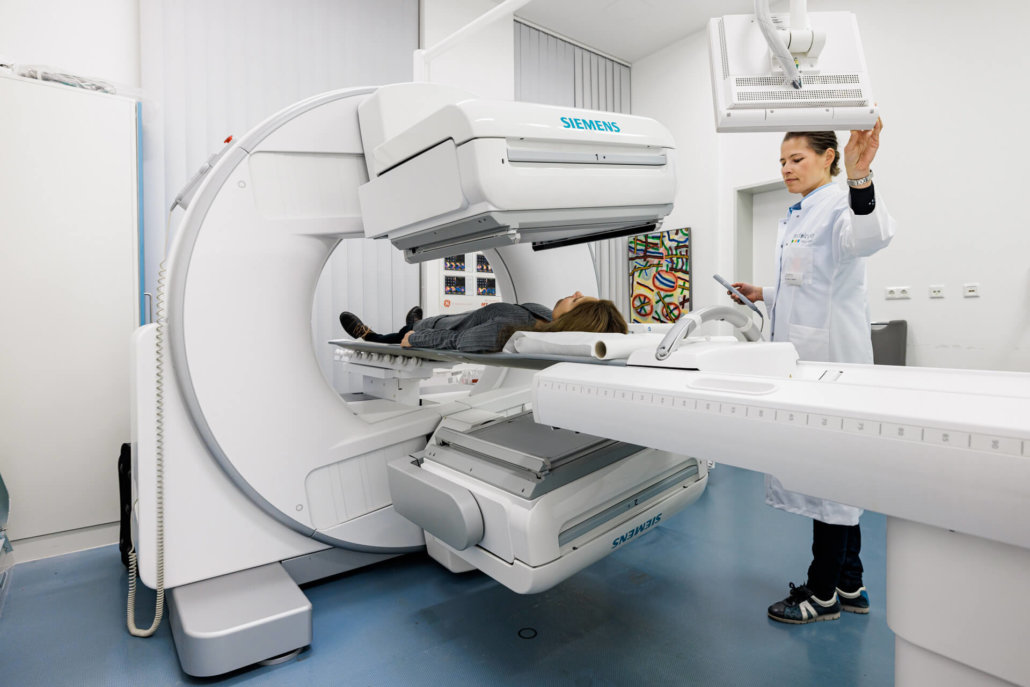Scintigraphy of the thyroid gland
Thyroid scintigraphy is a nuclear medicine examination method. It uses a low-level radioactive substance (usually technetium 99m) to measure how well iodine is absorbed by individual areas of the thyroid gland. The thyroid gland needs iodine for the formation of thyroid hormones.
approx. 30 min
Duration of examination
4-6 weeks before
No CT contrast medium containing iodine
c. 40%
the annual natural amount of radiation per scintigraphy
Where can you have a thyroid scintigraphy performed in Munich?
We offer thyroid scintigraphy at our nuclear medicine location in the Rotkreuzklinikum, Nymphenburgerstr.163. For compulsorily insured persons, we require a valid referral slip.

When is thyroid scintigraphy useful?
With sonography (ultrasound imaging), our specialists can get to the bottom of thyroid disorders. Size, texture as well as possible nodule formation are examined.
If nodules in the thyroid are detected sonographically or blood tests indicate thyroid dysfunction, thyroid scintigraphy is often required.
Thyroid scintigraphy can be used to image hormone production, or function, in individual areas of the thyroid gland. In this way, nodular changes in the thyroid gland can be assessed in terms of their functionality. A distinction is made between “hot/warm” and “cold” nodes. Furthermore, nodes can also store indifferently, i.e. they cannot be clearly classified into the above categories.
Detection of hot/warm and cold nodes
Hot nodules (autonomous adenomas) produce thyroid hormones unchecked, regardless of the amount needed. They usually correspond to benign growths of thyroid cells, but can cause hyperthyroidism.
Cold nodes do not show hormone production. Sometimes a cold lump can hide a malignant change.
How does a thyroid scintigraphy work?
In preparation for the examination, the radiopharmaceutical (mostly 99mTechnetium pertechnetate or iodide with 123iodine) is injected into a vein, usually in the arm. Once the substances have accumulated in the thyroid gland, they can be measured using a gamma camera.
The gamma camera records the radiation emitted by the radiopharmaceutical. This produces an image of the accumulations of the radiopharmaceutical in the thyroid gland, called a scintigram. A scintigram reveals hot, cold and warm nodules.
What do you need to know before the treatment?
Some substances can affect the result of a scintigraphy, such as iodine-containing drugs, thyroid hormones, or thyrostatic drugs. Therefore, please inform us in advance which medications you are taking. In addition, we ask you to inform us before a thyroid scintigraphy if examinations with iodine-containing X-ray contrast media have been performed at an earlier time. In most cases, the examination can also be performed while taking thyroid hormones. The prerequisite is a TSH level > 1.0.
Special case of suppression scintigraphy
In case of clinical suspicion of focal or diffuse autonomy in peripheral euthyroidism with unsuppressed basal TSH, it may be necessary to effectively suppress (=lower) basal TSH with thyroid hormone intake for a few days to then unmask autonomous adenomas (=hot nodules) by scintigraphy.
Your specialist will discuss the required dosage and duration of intake with you on site.
Precautions Pregnancy and breastfeeding
If scintigraphy is indicated during the sill period, interruption of breastfeeding for 24 hours (Tc-99m) is recommended.
What is the procedure for a scintigraphy at Radiologie München?
First, you will have a detailed educational consultation with our nuclear medicine physician and an ultrasound examination of the thyroid gland will be performed. If a scintigraphy is necessary, it is performed directly afterwards. The examination substance is injected via the arm vein and then you have to wait for about 15 minutes. You will then lie on the gamma camera for 5 minutes and images of the thyroid gland will be taken. After the evaluation, our nuclear medicine physician will discuss the results with you and make recommendations for further treatment – if necessary.
What are the risks and side effects of thyroid scintigraphy?
As with all drugs, side effects may occur in principle, but are not usually observed. Radiation exposure from thyroid scintigraphy is low and is about the same as an X-ray examination of the spine. If scintigraphy is necessary during the sill period, interruption of breastfeeding for 24 hours (Tc-99m) is recommended.


